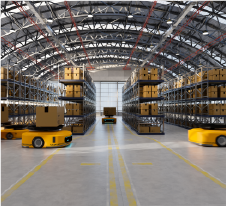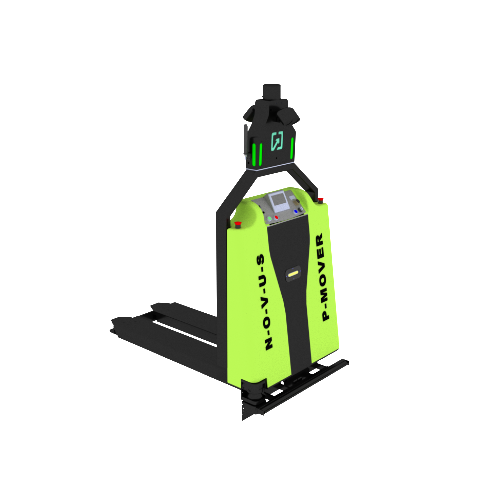In an era where automation continues to revolutionize industries, one innovation stands out for its groundbreaking potential: Autonomous Mobile Robots (AMRs). These intelligent machines have redefined traditional robotics, heralding a new era of independent navigation and operation within various sectors. Let’s delve deeper into AMRs to understand their capabilities, applications, and the transformative impact they bring to industries worldwide.
Understanding Autonomous Mobile Robots
Autonomous Mobile Robots (AMRs) represent a paradigm shift in robotics. Unlike their conventional counterparts, AMRs can navigate and perform tasks autonomously without the need for fixed pathways or human intervention. Their distinguishing features lie in integrating advanced technologies like sensors, mapping, and localization systems, enabling real-time decision-making and adaptive movement in dynamic environments.
Benefits of Utilizing Autonomous Mobile Robots

The adoption of AMRs brings forth a multitude of advantages across industries:
- Enhanced Safety: One of the primary advantages of AMRs is their capacity to minimize human exposure to hazardous environments. These robots can efficiently handle tasks that risk human health and safety, reducing workplace accidents.
- Increased Flexibility: AMRs demonstrate unparalleled adaptability, seamlessly transitioning between various tasks and accommodating changing operational needs. Their flexibility makes them ideal for handling diverse workflows efficiently.
- Improved Efficiency: AMR contributes significantly to increased productivity and reduced operational costs by optimizing workflows and streamlining operations. Their ability to work continuously and efficiently enhances overall operational efficiency.
Applications of Autonomous Mobile Robots
AMRs find applications across a spectrum of industries:
- Manufacturing: From material handling to intricate operations like assembly or welding, AMRs streamline processes in manufacturing facilities, enhancing production efficiency.
- Warehousing: AMRs automate inventory management and order picking in logistics and warehousing, significantly reducing processing times and errors.
- Healthcare: In healthcare settings, AMRs assist in transporting medication and medical equipment, as well as undertaking tasks such as room disinfection, contributing to a safer environment for patients and staff alike.
Challenges and Considerations
While the potential of Autonomous Mobile Robots is immense, their integration is challenging. One of the primary hurdles lies in ensuring seamless collaboration between humans and robots. As industries adopt AMRs, addressing concerns related to job displacement becomes imperative. However, the prevailing narrative isn’t one of replacement but augmentation—AMRs are designed to assist and collaborate with human workers, freeing them from mundane tasks to focus on more strategic and creative endeavors.
Another critical aspect to consider is the complexity of programming these robots. While AI and machine learning advancements have made great strides, programming AMRs to adapt swiftly to unforeseen scenarios remains challenging. Overcoming this challenge necessitates continuous innovation in AI algorithms and robust testing methodologies to ensure reliability in various environments.
Ethical Implications and Regulations
As AMRs become more integrated into daily operations, ethical considerations and regulations come into play. Discussions on ethical guidelines for using autonomous systems, ensuring accountability in decision-making, and setting clear boundaries for their operations are crucial. Privacy concerns and data security also demand attention, especially in industries like healthcare, where AMRs handle sensitive information and perform critical tasks.
Environmental Impact and Sustainability
Another aspect to highlight is the potential for AMRs to contribute to sustainability efforts. These robots optimize resource utilization, minimize energy consumption, and reduce waste by streamlining operations. Furthermore, they facilitate efficient inventory management, potentially decreasing overproduction and unnecessary stockpiling.
The Collaborative Future of Autonomous Mobile Robots
The synergy between humans and AMRs will redefine the work landscape. As technology advances, these robots will evolve into more sophisticated entities capable of executing tasks, learning, and adapting in real-time. Collaboration between industries, academia, and technology innovators will accelerate the development of safer, more intelligent, and more versatile AMRs.
Here’s a case study where India’s leading fast-moving electrical goods company, Havells implemented Autonomous Mobile Robots for their intralogistics solution.
Facing challenges in warehouse operations centered around manual trolley and pallet movements, Havells seeks to revolutionize its processes, addressing critical pain points while enhancing efficiency, reducing labor requirements, and ensuring worker safety.
Autonomous Intralogistics Solution: Reshaping Warehouse Operations
Havells recognized the limitations and inefficiencies inherent in their manual trolley and pallet movement processes. They opted for an autonomous intralogistics solution leveraging state-of-the-art mobile robots to revolutionize their warehouse operations.
Empowering Efficiency Through Automation
Integrating Autonomous Mobile Robots (AMRs) equipped with cutting-edge technology is the cornerstone of Havells’ warehouse transformation. These robots, fitted with sensors, cameras, and navigation systems, autonomously handle material movement, streamlining operations and optimizing efficiency.
Trolley Movement Reinvented
Mobile robots navigate the warehouse floor, executing seamless trolley transportation from one location to another. Task assignments are seamlessly managed through interaction with the warehouse management system, ensuring timely deliveries and optimizing workflow dynamics.
Precision in Pallet Handling
Advanced robotic systems with specialized lifting mechanisms automate pallet handling tasks. These robots proficiently pick up, transport, and position pallets in designated areas, such as storage racks or loading docks, ensuring precision and minimizing errors or damages during handling.
Efficient Centralized Control
A centralized control system orchestrates the fleet of mobile robots in real-time, optimizing route planning, task allocation, and coordination. This system ensures synchronized operations, facilitating smooth and efficient movements throughout the warehouse.
Realizing Transformative Benefits
The implementation of autonomous intralogistics with mobile robots yields a spectrum of advantages for Havells:
- Enhanced Operational Efficiency: The automated material handling processes significantly boost throughput, reduce cycle times, and elevate order fulfillment rates. This improvement resonates with heightened customer satisfaction and drives business growth.
- Optimized Workforce: With reduced reliance on manual labor for trolley and pallet movement, the workforce is optimized for more value-added tasks, fostering innovation and quality enhancements within the company’s operations.
- Precision and Traceability: Mobile robots, following predefined routes with precise positioning systems, ensure accuracy in material placement. This minimizes errors, enhances inventory management, and augments overall traceability within the warehouse.
- Elevated Safety Standards: Automation eliminates manual lifting, mitigating the risk of workplace injuries. Safety features like collision avoidance systems equipped with these robots ensure a safer working environment for Havells’ employees.
Integrating autonomous intralogistics with mobile robots heralds a new era for Havells’, marking a strategic leap toward optimized operations, heightened efficiency, and a safer workplace. This transformative approach underscores Havells’ commitment to innovation and sets a precedent for the future of warehouse management in the FMCD industry.
The Future of Autonomous Mobile Robots
Looking ahead, the future of AMRs holds immense promise. Anticipated technological advancements are poised to enhance their capabilities further, enabling them to take on more complex tasks and navigate even more challenging environments. These advancements will likely profoundly impact various industries, driving efficiency and innovation.
Conclusion
Autonomous Mobile Robots represent a pivotal innovation reshaping the landscape of automation. Their ability to operate while ensuring safety, flexibility, and efficiency makes them indispensable across industries. As we advance further into the future, the evolution of AMRs will continue to play a crucial role in revolutionizing automation, empowering industries to achieve unprecedented levels of productivity and innovation.
The transformative potential of AMRs is undeniable. Embracing this technology is not just about automating tasks; it’s about unlocking new possibilities and reshaping the future of work and industry. For more information schedule a visit to our plant to see live demo of Autonomous Mobile Robots.
FAQs
What’s the difference between AGV and AMR?
Automated Guided Vehicles (AGVs) and Autonomous Mobile Robots (AMRs) differ in their level of autonomy and flexibility.
- AGVs follow fixed paths, often guided by wires, magnetic strips, or predefined routes. If an obstacle blocks their path, they stop until the way is cleared.
- AMRs navigate dynamically using sensors, cameras, and onboard intelligence. They can detect and avoid obstacles, rerouting themselves in real time without external guidance. This makes AMRs more versatile for complex environments.
How fast is an autonomous mobile robot?
The speed of an Autonomous Mobile Robot (AMR) varies based on its design and application. Typically, AMRs operate at speeds between 1 to 5 mph (1.6 to 8 km/h). Some industrial models can reach higher speeds depending on the task, while safety measures ensure they adjust speeds in busy or hazardous environments.
Why are autonomous robots important?
Autonomous robots are vital for improving efficiency, safety, and productivity across industries. They handle repetitive tasks, reduce human error, and enhance operational consistency. In sectors like logistics, manufacturing, and healthcare, autonomous robots streamline workflows, optimize resource use, and free employees to focus on higher-value tasks. They also minimize risks in hazardous environments.
What are the features of autonomous mobile robots?
Key features of Autonomous Mobile Robots (AMRs) include:
- Navigation and Mapping – Uses LIDAR, cameras, and sensors for real-time mapping and navigation.
- Obstacle Detection and Avoidance – Adjusts routes to avoid collisions dynamically.
- Scalability – Easily integrates with existing systems and scales to meet growing operational needs.
- Adaptive Learning – Learns and improves through AI-driven algorithms.
- Remote Monitoring – This can be controlled and monitored remotely, enhancing oversight and operational efficiency.
- Task Flexibility – Performs a range of tasks, from material transport to inventory scanning.























